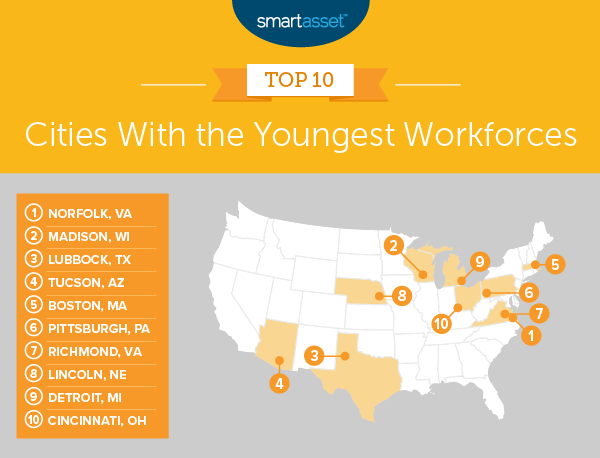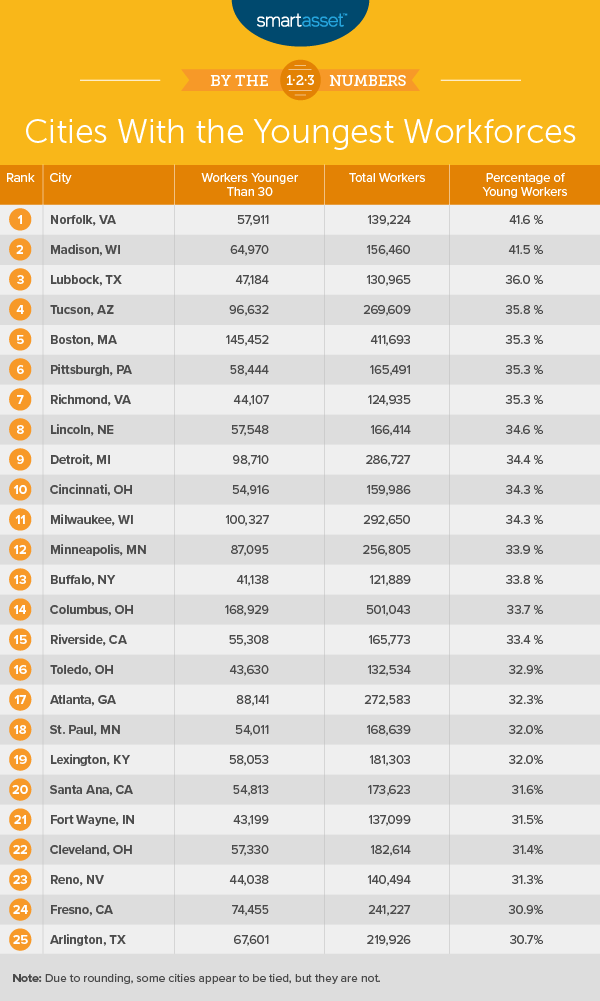 Despite the aging of the American workforce, with adults 65 and older twice as likely to be working now compared to 1985, Census data shows that one in four workers in 2018 was still younger than the age of 30. Entering the workforce at a younger age can be advantageous, since it means there’s more time to save up for goals such as homeownership and retirement. It is important to note, however, that young workers have flocked to some cities more than others. In this study, SmartAsset examined the cities with the youngest workforces.
Despite the aging of the American workforce, with adults 65 and older twice as likely to be working now compared to 1985, Census data shows that one in four workers in 2018 was still younger than the age of 30. Entering the workforce at a younger age can be advantageous, since it means there’s more time to save up for goals such as homeownership and retirement. It is important to note, however, that young workers have flocked to some cities more than others. In this study, SmartAsset examined the cities with the youngest workforces.
Considering data on the 100 largest cities in the U.S., we analyzed the number of workers younger than the age of 30 as a percentage of total workers. For details on our data sources and how we put all the information together to create our final rankings, check out the Data and Methodology section below.
Key Findings
- College towns rank well. Many of the cities at the top of our list have large colleges or universities in the area, suggesting that many students are working throughout their time in school or staying in the area after they graduate. In particular, Madison, Wisconsin, ranking second, and Boston, Massachusetts, ranking fifth, are known for their large student populations.
- The percentage of young workers varies greatly between cities. There is a range of more than 24% between the city at the top of our list with the highest percentage of workers under 30 (Norfolk, Virginia at 41.6%) and the city at the bottom with the lowest percentage of young workers (Fremont, California at 17.5%).

1. Norfolk, VA
More than 40% of the workforce in Norfolk, Virginia is younger than the age of 30. According to Census data, there are about 139,000 workers in the city and roughly 58,000 of those workers are between 16 and 29 years old. As only about 75,000 residents are under the age of 30, the labor force participation rate for people between the ages of 16 and 29 is greater than 77%, significantly higher than the national average of 68.1%. Taxes are an important factor of income, so it’s crucial that employees understand what their true take-home pay looks like before budgeting.
2. Madison, WI
The 2018 labor force participation rate for residents 29 and younger in Madison, Wisconsin was 74.4%. There were 87,381 residents between the ages of 16 and 29 in the city, and about 65,000 of those residents were employed. As there are a total of roughly 156,460 workers, this means that upwards of 41% of the workforce consists of millennials or Generation Z-ers. This indicates more opportunity for young professionals in the area.
3. Lubbock, TX
Lubbock, Texas has a workforce of about 131,000 people, about 47,000 of whom (roughly 36%) were younger than 30 in 2018. This concentration of young workers is about 10.5% higher than the national average of 25.6%.
4. Tucson, AZ
Perhaps because of its relatively large senior population, Tucson, Arizona has a relatively low overall labor force participation rate (61.1%). The labor force participation rate for residents between 16 and 29 years old is much higher, at 68.3%. In 2018, there were almost 97,000 workers between those ages compared to the total workforce, which was 269,609. As a result, more than one in three workers was younger than the age of 30.
5. Boston, MA
Boston, Massachusetts is known for its young population given the high concentration of colleges and universities throughout the city. Census data suggests that many students are either working throughout college or staying in the city after graduating. In 2018, 35.33% of the Boston workforce was younger than 30. Younger workers in Boston who are renting with a roommate might be able to put more money from each paycheck toward retirement savings.
6. Pittsburgh, PA
There were about 58,500 workers younger than 30 in Pittsburgh, Pennsylvania in 2018. As there were a total of fewer than 165,500 workers, the percentage of young workers in the city is the sixth-highest across all 100 cities in our study. Specifically, 35.32% of the employed population was between the ages 16 and 29.
7. Richmond, VA
Richmond, Virginia has the lowest number of workers of any city in our top 10. However, more than a third of them – about 35.3% (the seventh-highest rate for this metric) – are younger than age 30. Specifically, of the total 125,000 workers, 44,107 were between the ages of 16 and 29. Young workers in Richmond who want to get a head start with their financial planning can take a look at the information we provide on the top financial advisors in the area.
8. Lincoln, NE
Close to 58,000 of the total 166,414 workers in Lincoln, Nebraska were younger than the age of 30 in 2018. In percentage terms, 34.6% of the workforce was between 16 and 29 years old. Having an income means being able to allocate your spending wisely to meet both needs and wants. Younger workers like the ones in Lincoln are spending differently than their counterparts in previous generations.
9. Detroit, MI
Though Detroit, Michigan has a relatively low labor force participation rate (at 54.5%, it’s the lowest rate for this metric across all 100 cities we examined), many people who are a part of the labor force tend to be young. In 2018, about 34% of the labor force was younger than 30. Moreover, the labor force participation rate for people between the ages of 16 and 29 was about 66.4%, more than 10% higher than the rate for the full population.
10. Cincinnati, OH
More than a third of the total workforce in Cincinnati, Ohio was under the age of 30 in 2018. Like in Detroit, the labor force participation rate in Cincinnati for residents 16 to 29 years of age was higher than that for all residents 16 years and older. More than 70% of residents younger than 30 were part of the labor force, compared to 65.5% of all residents.
Cincinnati is also the top city in the U.S. for beer drinkers, allowing plenty of options for young workers to get together at the end of the day, or friends to celebrate a new job.

Data and Methodology
To find the cities with the youngest workforces, we looked at data on the 100 largest cities in the U.S. Using population data and labor force participation rates from the Census Bureau’s 2018 1-year American Community Survey, we found the percentage of the workforce younger than the age of 30 (i.e. between 16 and 29 years old) in each city. Cities with the highest percentages of young workers ranked at the top of the list, and those with the lowest percentages of young workers ranked at the bottom of the list.
Savings Tips for Young Workers
- Don’t put off saving and investing. If you are at the beginning of your career, you have plenty of time to build up your savings and take advantage of compound interest. Take a look at our investment calculator to see how your investment can grow over time.
- Contribute to a 401(k) or IRA. One of the best ways to save for retirement is through a retirement savings account. A 401(k) is an employer-sponsored defined contribution plan in which you divert pre-tax portions of your monthly paycheck into a retirement account. Some employers will also match your 401(k) contributions up to a certain percentage of your salary, meaning that if you chose not to contribute, you are essentially leaving money on the table. Our 401(k) calculator can help you determine what you saved for retirement so far and how much more you may need. If your employer does not offer a 401(k) plan, an IRA is another great option.
- Consider a financial advisor. A financial advisor can help you make smarter financial decisions to be in better control of your money. Finding the right financial advisor who fits your needs doesn’t have to be hard. SmartAsset’s free tool matches you with financial advisors in your area in five minutes. If you’re ready to be matched with local advisors that will help you achieve your financial goals, get started now.
Questions about our study? Contact us at press@smartasset.com
Photo credit: ©iStock.com/sturti